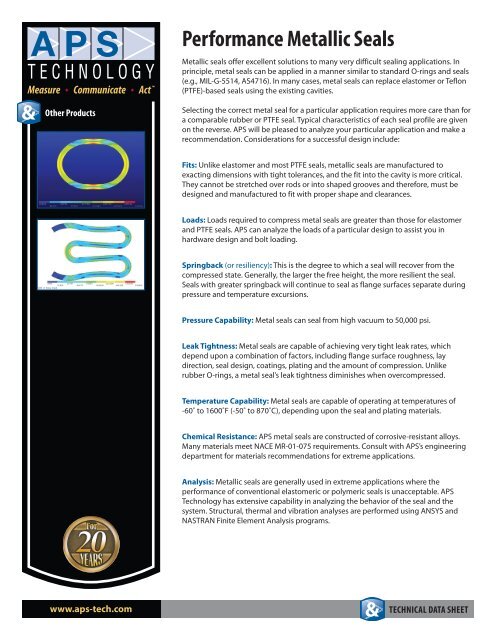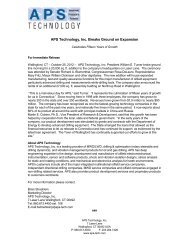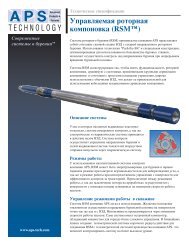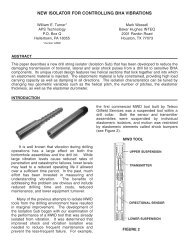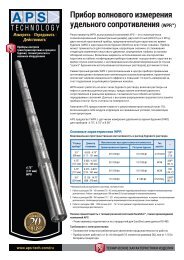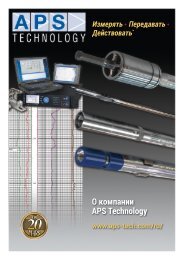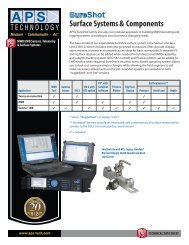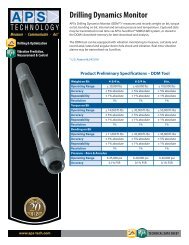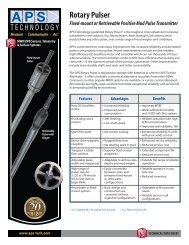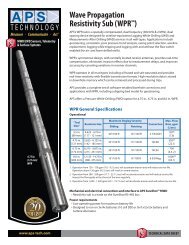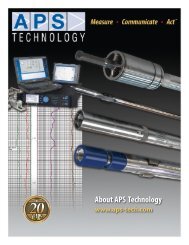Download the Metallic Seals TDS for detailed ... - APS Technology
Download the Metallic Seals TDS for detailed ... - APS Technology
Download the Metallic Seals TDS for detailed ... - APS Technology
- No tags were found...
You also want an ePaper? Increase the reach of your titles
YUMPU automatically turns print PDFs into web optimized ePapers that Google loves.
Measure ◆ Communicate ◆ Act O<strong>the</strong>r ProductsPer<strong>for</strong>mance <strong>Metallic</strong> <strong>Seals</strong><strong>Metallic</strong> seals offer excellent solutions to many very difficult sealing applications. Inprinciple, metal seals can be applied in a manner similar to standard O-rings and seals(e.g., MIL-G-5514, AS4716). In many cases, metal seals can replace elastomer or Teflon(PTFE)-based seals using <strong>the</strong> existing cavities.Selecting <strong>the</strong> correct metal seal <strong>for</strong> a particular application requires more care than <strong>for</strong>a comparable rubber or PTFE seal. Typical characteristics of each seal profile are givenon <strong>the</strong> reverse. <strong>APS</strong> will be pleased to analyze your particular application and make arecommendation. Considerations <strong>for</strong> a successful design include:Fits: Unlike elastomer and most PTFE seals, metallic seals are manufactured toexacting dimensions with tight tolerances, and <strong>the</strong> fit into <strong>the</strong> cavity is more critical.They cannot be stretched over rods or into shaped grooves and <strong>the</strong>re<strong>for</strong>e, must bedesigned and manufactured to fit with proper shape and clearances.Loads: Loads required to compress metal seals are greater than those <strong>for</strong> elastomerand PTFE seals. <strong>APS</strong> can analyze <strong>the</strong> loads of a particular design to assist you inhardware design and bolt loading.Springback (or resiliency): This is <strong>the</strong> degree to which a seal will recover from <strong>the</strong>compressed state. Generally, <strong>the</strong> larger <strong>the</strong> free height, <strong>the</strong> more resilient <strong>the</strong> seal.<strong>Seals</strong> with greater springback will continue to seal as flange surfaces separate duringpressure and temperature excursions.Pressure Capability: Metal seals can seal from high vacuum to 50,000 psi.Leak Tightness: Metal seals are capable of achieving very tight leak rates, whichdepend upon a combination of factors, including flange surface roughness, laydirection, seal design, coatings, plating and <strong>the</strong> amount of compression. Unlikerubber O-rings, a metal seal’s leak tightness diminishes when overcompressed.Temperature Capability: Metal seals are capable of operating at temperatures of-60˚ to 1600˚F (-50˚ to 870˚C), depending upon <strong>the</strong> seal and plating materials.Chemical Resistance: <strong>APS</strong> metal seals are constructed of corrosive-resistant alloys.Many materials meet NACE MR-01-075 requirements. Consult with <strong>APS</strong>’s engineeringdepartment <strong>for</strong> materials recommendations <strong>for</strong> extreme applications.Analysis: <strong>Metallic</strong> seals are generally used in extreme applications where <strong>the</strong>per<strong>for</strong>mance of conventional elastomeric or polymeric seals is unacceptable. <strong>APS</strong><strong>Technology</strong> has extensive capability in analyzing <strong>the</strong> behavior of <strong>the</strong> seal and <strong>the</strong>system. Structural, <strong>the</strong>rmal and vibration analyses are per<strong>for</strong>med using ANSYS andNASTRAN Finite Element Analysis programs.www.aps-tech.comTECHNICAL DATA SHEET
Per<strong>for</strong>mance <strong>Metallic</strong> <strong>Seals</strong>Measure ◆ Communicate ◆ Act O<strong>the</strong>r ProductsO-RINGPressures: 1,000 psi nonvented5,000 - 25,000 psi ventedTemperature: 900˚F (480˚C) (321 stainless)Load: ModerateSpringback: LowApplications: > For rigid, stable connections> Lowest-cost metal sealC-RINGC-LIMSLSPressures: 8,000 - 25,000 psi50,000 psi special designsTemperature: -60˚ to 1600˚F (-50˚ to 870˚C)Load: ModerateSpringback: MediumApplications: > Stable connections, minor separationpermissible> Highest temperature ratingPressures: 8,000 - 25,000 psiTemperature: -60˚ to 1200˚F (-50˚ to 650˚C)Load: HighSpringback: LowApplications: > Used as high-per<strong>for</strong>mance compression(crush) sealPressures: 5,000 - 22,000 psi35,000 psi special designsTemperature: -60˚ to 1200˚F (-50˚ to 650˚C)Load: HighSpringback: MediumApplications: > Most tolerant seal <strong>for</strong> surfaceimperfections, waviness> High vacuum capableHeadquarters ◆ Walling<strong>for</strong>d ◆ USA7 Laser Lane, Walling<strong>for</strong>d, CT 06492 USAPhone: 860-613-4450 ◆ Fax: 203-284-7428contact@aps-tech.comHouston ◆ USA15415 International Plaza Dr., Suite #150Houston, TX 77032 USAPhone: 281-847-3700E-RINGPressures: 5,000 psiTemperature: -60˚ to 1600˚F (-50˚ to 870˚C)Load: LowSpringback: HighApplications: > Hot air ducts, gas turbine engines, valveseats, turbochargersRev. 131030-vB.02Specifications subject to change without notice.© <strong>APS</strong> <strong>Technology</strong>, Inc. 2013www.aps-tech.comTECHNICAL DATA SHEET


